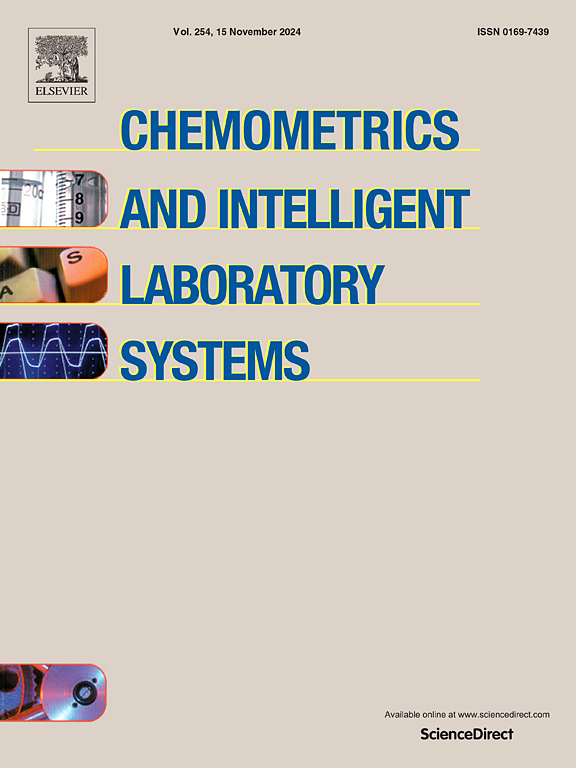The Raman spectroscopy combined with selective state-space algorithm for constructing a rapid disease diagnosis model
IF 3.7
2区 化学
Q2 AUTOMATION & CONTROL SYSTEMS
Chemometrics and Intelligent Laboratory Systems
Pub Date : 2025-03-14
DOI:10.1016/j.chemolab.2025.105375
引用次数: 0
Abstract
In recent years, how to construct a rapid disease diagnosis model is still the focus of research in the artificial medical field. Raman spectroscopy is widely used in the medical diagnostic field because of its non-invasive, rapid and highly sensitive properties. However, in Raman spectroscopy, the resonance of multiple functional groups and compounds can result in identical characteristic peaks within the spectrum, which affects the accuracy of this technique in the field of disease diagnosis. Existing studies often focus solely on capturing either local or global information from Raman spectra, potentially causing models to overlook interactions between characteristic peaks or the intricate details within individual peaks of a single spectrum. To address these issues, this paper proposes a medical Raman spectroscopy model, MRSMamba, based on the selective state-space algorithm. The spectral data is first encoded into labeled sequences through a Patch module, which are then input into the Mamba block of the selective state-space algorithm. This model leverages the unique features of selective state-space algorithms to capture detailed local information within each labeled segment while preserving global spectral characteristics, thereby constructing a rapid disease diagnosis model. For the first time, the selective state-space algorithm is applied to the field of medical Raman spectroscopy, with modifications tailored for Raman data. During the encoding phase, the paper also introduces an innovative sequence labeling module designed specifically for the Mamba framework. Experiments using the proposed MRSMamba model were conducted on multiple disease datasets, including thyroid benign and malignant tumor datasets, cancer datasets, and autoimmune disease datasets. We evaluated MRSMamba on a binary classification task involving 99 cases of benign and malignant thyroid tumors, achieving an Accuracy of 0.9286, a recall of 0.9286, a Specificity of 0.9285, and an F1-score of 0.9286. MRSMamba demonstrated a 3.57 % higher accuracy compared to the MLP model. Additionally, the model was tested on a four-class cancer classification task, achieving an Accuracy of 0.7813, a Recall of 0.7042, a Specificity of 0.9165, and an F1-score of 0.7381. MRSMamba outperformed the standalone encoding module PACE by 6.25 % in terms of accuracy. Furthermore, the model was evaluated on an autoimmune disease classification task, achieving an accuracy of 0.9813 and an F1-score of 0.9793. These results highlight the exceptional performance of MRSMamba in the field of rapid disease diagnosis using Raman spectroscopy, demonstrating significant practical application potential.
将拉曼光谱与选择性状态空间算法相结合,构建疾病快速诊断模型
近年来,如何构建快速疾病诊断模型仍是人工医学领域研究的热点。拉曼光谱以其无创、快速、高灵敏度等特点在医学诊断领域得到广泛应用。然而,在拉曼光谱中,多个官能团和化合物的共振可能导致光谱内相同的特征峰,这影响了该技术在疾病诊断领域的准确性。现有的研究通常只关注从拉曼光谱中捕获局部或全局信息,这可能导致模型忽略了特征峰之间的相互作用或单个光谱中单个峰内的复杂细节。为了解决这些问题,本文提出了一种基于选择性状态空间算法的医学拉曼光谱模型MRSMamba。光谱数据首先通过Patch模块编码成标记序列,然后输入到选择状态空间算法的曼巴块中。该模型利用选择性状态空间算法的独特特性,在保留全局谱特征的同时,捕获每个标记段内的详细局部信息,从而构建快速疾病诊断模型。首次将选择状态空间算法应用于医学拉曼光谱领域,并针对拉曼数据进行了相应的修改。在编码阶段,本文还介绍了专门为曼巴框架设计的创新序列标记模块。利用提出的MRSMamba模型在多个疾病数据集上进行了实验,包括甲状腺良恶性肿瘤数据集、癌症数据集和自身免疫性疾病数据集。我们对99例良性和恶性甲状腺肿瘤的二元分类任务进行了MRSMamba评估,准确率为0.9286,召回率为0.9286,特异性为0.9285,f1评分为0.9286。与MLP模型相比,MRSMamba模型的准确率提高了3.57%。此外,该模型在四类癌症分类任务上进行了测试,准确率为0.7813,召回率为0.7042,特异性为0.9165,f1评分为0.7381。MRSMamba在准确性方面比独立编码模块PACE高出6.25%。此外,对该模型进行自身免疫性疾病分类任务评估,准确率为0.9813,f1评分为0.9793。这些结果突出了MRSMamba在拉曼光谱快速疾病诊断领域的卓越表现,展示了巨大的实际应用潜力。
本文章由计算机程序翻译,如有差异,请以英文原文为准。
求助全文
约1分钟内获得全文
求助全文
来源期刊
CiteScore
7.50
自引率
7.70%
发文量
169
审稿时长
3.4 months
期刊介绍:
Chemometrics and Intelligent Laboratory Systems publishes original research papers, short communications, reviews, tutorials and Original Software Publications reporting on development of novel statistical, mathematical, or computer techniques in Chemistry and related disciplines.
Chemometrics is the chemical discipline that uses mathematical and statistical methods to design or select optimal procedures and experiments, and to provide maximum chemical information by analysing chemical data.
The journal deals with the following topics:
1) Development of new statistical, mathematical and chemometrical methods for Chemistry and related fields (Environmental Chemistry, Biochemistry, Toxicology, System Biology, -Omics, etc.)
2) Novel applications of chemometrics to all branches of Chemistry and related fields (typical domains of interest are: process data analysis, experimental design, data mining, signal processing, supervised modelling, decision making, robust statistics, mixture analysis, multivariate calibration etc.) Routine applications of established chemometrical techniques will not be considered.
3) Development of new software that provides novel tools or truly advances the use of chemometrical methods.
4) Well characterized data sets to test performance for the new methods and software.
The journal complies with International Committee of Medical Journal Editors'' Uniform requirements for manuscripts.

 求助内容:
求助内容: 应助结果提醒方式:
应助结果提醒方式:


